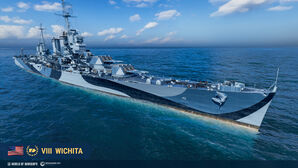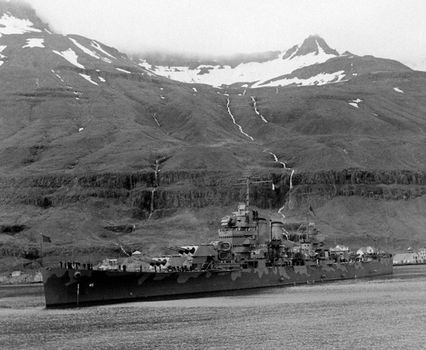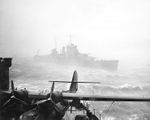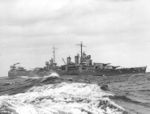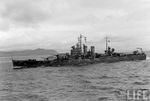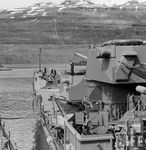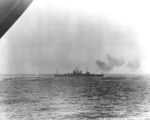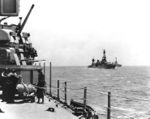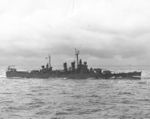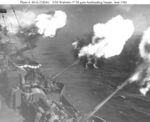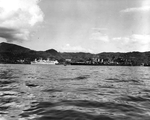Wichita
| Revision as of 19:41, 29 December 2018 inaccuracies | Revision as of 18:32, 30 April 2020 Remove references to premium consumables as per 0.9.4. | |||
15 intermediate revisions by 8 users not shown | ||||
| Line 9: | Line 9: | |||
| |Performance=<!-- write text about performance in battles below --> | |Performance=<!-- write text about performance in battles below --> | |||
| ? | ''{{#var:ship_name}}'' is the first Tier VIII | + | ''{{#var:ship_name}}'' is the first Tier VIII Premium American cruiser, and the second premium heavy cruiser available for the US tech tree after the Tier VII ''[[Indianapolis]]'' (with the exception of ''[[Salem]]''). Like her tech-tree counterpart, ''[[Baltimore]]'', ''{{#var:ship_name}}'' possesses 27mm bow plating, allowing her to resist being over-matched by the 380mm guns found on many battleships of her tier. | |
| ? | ''{{#var:ship_name}}'' | + | ''{{#var:ship_name}}'' has some key differences from her tech tree counterpart. Unlike ''Baltimore'', she does not have the famous American "super-heavy" AP shells, and continues to use the same AP rounds fired by Tier VII American cruiser ''[[New Orleans]]''. This gives her slightly less AP punch than ''Baltimore''. Additionally, her anti-aircraft suite is not quite as robust; her mid-range aura is about half as good as ''Baltimore''’s and her mid-range flak is roughly 2/3 as strong. On the upside, she is notably stealthier than ''Baltimore'': 9.5 km surface detection when fully rigged for stealth, and her handling characteristics bear a strong resemblance to those of Tier VII American premium cruiser ''[[Boise]]'' (fitting, given that ''{{#var:ship_name}}''’s hull is essentially that of a ''Brooklyn''-class light cruiser). She has more speed and is quicker to respond to rudder commands than her tech tree cousin. | |
| ? | + | ''{{#var:ship_name}}'' plays nearly identically to ''Baltimore'', with the only exception being her marginally less effective firepower. Like other American heavy cruisers, using islands as hard cover and utilizing her {{Surveillance Radar}} to support friendly destroyers should be her primary objectives. Her rather high shell arcs make leading targets at maximum range challenging, but not impossible. Despite lacking the super heavy AP shells of the tech tree cruisers, her AP is still quite powerful against broadside targets , and captains should use her AP whenever possible given its improved ricochet and auto-bounce angles. | ||
| + | ||||
| + | Fans of American heavy cruiser play should have few issues making effective use of ''{{#var:ship_name}}''. | |||
| + | ||||
| + | {{AnnoWiki|content= | |||
| + | '''[https://forum.worldofwarships.com/topic/183322-premium-ship-review-118-wichita/ LittleWhiteMouse's Premium Ship Review: Wichita] from the NA forums'''}} | |||
| |Pros=<!-- write list of positive points below. use * as in ordinary wiki-list. --> | |Pros=<!-- write list of positive points below. use * as in ordinary wiki-list. --> | |||
| ? | * Extremely good concealment for | + | * Extremely good concealment for her tier; ties ''[[Edinburgh]]'' as the stealthiest Tier VIII cruiser. | |
| ? | * Can mount | + | * Can mount {{Surveillance Radar}}. | |
| ? | * Good balance of firepower and mobility | + | * Good balance of firepower and mobility. | |
| + | * Fastest American heavy cruiser in the game (33.6 knots). | |||
| |Cons=<!-- write list of negative points below. use * as in ordinary wiki-list. --> | |Cons=<!-- write list of negative points below. use * as in ordinary wiki-list. --> | |||
| ? | * Unlike her tech | + | * Unlike her tech tree counterpart ''[[Baltimore]]'', ''{{#var:ship_name}}'' lacks the super heavy AP shells on her main battery. | |
| * Shell arcs can make hitting targets at range difficult. | * Shell arcs can make hitting targets at range difficult. | |||
| * Very weak torpedo damage mitigation at only 4%. | * Very weak torpedo damage mitigation at only 4%. | |||
| ? | * | + | * Armor can be overmatched by 406mm guns. | |
| + | * No torpedo armament (like all other American cruisers at Tier VI and above). | |||
| |Research=<!-- write text about priority sequence of research below --> | |Research=<!-- write text about priority sequence of research below --> | |||
| Line 36: | Line 43: | |||
| *'''Slot 1''': {{Main Armaments Modification 1}} | *'''Slot 1''': {{Main Armaments Modification 1}} | |||
| *'''Slot 2''': {{Damage Control System Modification 1}} | *'''Slot 2''': {{Damage Control System Modification 1}} | |||
| ? | *'''Slot 3''': {{Aiming Systems Modification 1}} or {{AA Guns Modification | + | *'''Slot 3''': {{Aiming Systems Modification 1}} or {{AA Guns Modification 1}} | |
| *'''Slot 4''': {{Propulsion Modification 2}} or {{Steering Gears Modification 2}} | *'''Slot 4''': {{Propulsion Modification 2}} or {{Steering Gears Modification 2}} | |||
| *'''Slot 5''': {{Concealment System Modification 1}} | *'''Slot 5''': {{Concealment System Modification 1}} | |||
| Line 44: | Line 51: | |||
| '''General-Purpose Build:''' The standard load for a cruiser, this generally focuses on anti-surface capabilities. {{Main Armaments Modification 1}} is the optimal choice for '''Slot 1''', as it will help keep the main battery of ''Wichita'', her primary means of dealing damage, operational in the face of heavy fire. '''Slot 3''' is best filled by {{Aiming Systems Modification 1}}, to decrease the dispersion of the main battery guns. Players can choose between {{Propulsion Modification 2}} or {{Steering Gears Modification 2}} for '''Slot 4''', depending on which better suits their play-style. The former improves acceleration and deceleration, and will benefit players who adopt a more static style of play involving firing at targets over islands. The latter will be more preferable to players that tend to be more mobile and actively avoid fire rather than relying on island cover. Finally, {{Concealment System Modification 1}} remains the player's best choice for '''Slot 5''', to optimize her already excellent concealment. | '''General-Purpose Build:''' The standard load for a cruiser, this generally focuses on anti-surface capabilities. {{Main Armaments Modification 1}} is the optimal choice for '''Slot 1''', as it will help keep the main battery of ''Wichita'', her primary means of dealing damage, operational in the face of heavy fire. '''Slot 3''' is best filled by {{Aiming Systems Modification 1}}, to decrease the dispersion of the main battery guns. Players can choose between {{Propulsion Modification 2}} or {{Steering Gears Modification 2}} for '''Slot 4''', depending on which better suits their play-style. The former improves acceleration and deceleration, and will benefit players who adopt a more static style of play involving firing at targets over islands. The latter will be more preferable to players that tend to be more mobile and actively avoid fire rather than relying on island cover. Finally, {{Concealment System Modification 1}} remains the player's best choice for '''Slot 5''', to optimize her already excellent concealment. | |||
| ? | '''Anti-Aircraft Build:''' Although her Anti-Aircraft firepower is inferior to that of ''[[Baltimore]]'' across the board, it is still among the best of | + | '''Anti-Aircraft Build:''' Although her Anti-Aircraft firepower is inferior to that of ''[[Baltimore]]'' across the board, it is still among the best of the Tier VIII cruisers, and like most American cruisers is worth investing into as an alternate build. For the AA build, the player will have several deviations in their module upgrades from the General Purpose Build. In '''Slot 1''', the player may choose to take {{Auxiliary Armaments Modification 1}} in order to double the durability of their anti-aircraft guns, giving greater longevity to their AA power. In '''Slot 2''', if the player has access to the Special Upgrade {{Defensive AA Fire Modification 1}}, they are advised to utilize it in order to increase the active time of the {{Defensive AA Fire}} consumable by 20%. In '''Slot 3''', captains should replace {{Aiming Systems Modification 1}} with {{AA Guns Modification 1}} to increase the number of flak bursts from their mid- and long-range batteries. These upgrades should be taken in combination with the optimal Captain Skills in order to maximize their affects on the player's anti-aircraft battery. | |
| |CommanderSkills=<!-- write text about best set of Commander Skills below --> | |CommanderSkills=<!-- write text about best set of Commander Skills below --> | |||
| + | The following information is provided for players who wish to create a permanent captain for the ship. Those players who are retraining captains or using the ship to gain extra experience for a captain should consult the page relevant to the ship to which the captain will be assigned. | |||
| ? | {{Commander Skills | + | {{Commander Skills 2 | |
| ? | | | + | <!-- This version enables a '0' rating. Use it for skills that have no effect (e.g. Improved Engines on a non-CV) or are detrimental to the ship. They should mirror what appears in the game client. --> | |
| ? | | | + | | rating11 = 3 <!-- Priority Target --> | |
| ? | | | + | | rating12 = 2 <!-- Preventive Maint --> | |
| ? | | | + | | rating13 = 2 <!-- Expert Loader --> | |
| ? | | Direction Center for | + | | rating14 = 0 <!-- Air Supremacy --> | |
| ? | | | + | | rating15 = <!-- Direction Center for Fighters --> | |
| ? | | Incoming Fire Alert | + | | rating16 = 0 <!-- Improved Engine Boost --> | |
| ? | | | + | | rating17 = 1 <!-- Incoming Fire Alert --> | |
| + | | rating18 = 0 <!-- Last Gasp --> | |||
| ? | | | + | | rating21 = 1 <!-- High Alert --> | |
| ? | | Jack of All Trades | + | | rating22 = 2 <!-- Jack of All Trades --> | |
| ? | | Expert Marksman | + | | rating23 = 2 <!-- Expert Marksman --> | |
| ? | | Torpedo Acceleration | + | | rating24 = 0 <!-- Torpedo Acceleration --> | |
| ? | | Smoke Screen Expert | + | | rating25 = 0 <!-- Smoke Screen Expert --> | |
| ? | | | + | | rating26 = 0 <!-- Improved Engines --> | |
| ? | | Adrenaline Rush | + | | rating27 = 3 <!-- Adrenaline Rush --> | |
| ? | | Last Stand | + | | rating28 = <!-- Last Stand --> | |
| ? | | Basics of Survivability | + | | rating31 = <!-- Basics of Survivability --> | |
| ? | | Survivability Expert | + | | rating32 = <!-- Survivability Expert--> | |
| ? | | Torpedo Armament Expertise | + | | rating33 = 0 <!-- Torpedo Armament Expertise--> | |
| ? | | | + | | rating34 = 0 <!-- Aircraft Armor --> | |
| ? | | Basic Firing Training | + | | rating35 = 2 <!-- Basic Firing Training --> | |
| ? | | | + | | rating36 = 2 <!-- Superintendent --> | |
| ? | | | + | | rating37 = 3 <!-- Demolition Expert --> | |
| ? | | | + | | rating38 = 1 <!-- Vigilance --> | |
| ? | | Manual Fire Control for Secondary Armament | + | | rating41 = <!-- Manual Fire Control for Secondary Armament --> | |
| ? | | Fire Prevention | + | | rating42 = <!-- Fire Prevention --> | |
| ? | | Inertia Fuse for HE Shells | + | | rating43 = <!-- Inertia Fuse for HE Shells --> | |
| ? | | | + | | rating44 = 0 <!-- Sight Stabilization --> | |
| ? | | Advanced Firing Training | + | | rating45 = 2 <!-- Advanced Firing Training --> | |
| ? | | | + | | rating46 = <!-- Massive AA Fire --> | |
| ? | | Radio Position Finding | + | | rating47 = 1 <!-- Radio Position Finding --> | |
| ? | | Concealment Expert | + | | rating48 = 3 <!-- Concealment Expert --> | |
| }} | }} | |||
| Line 91: | Line 100: | |||
| * '''Slot 2:''' {{Defensive AA Fire}} '''or''' {{Hydroacoustic Search}} | * '''Slot 2:''' {{Defensive AA Fire}} '''or''' {{Hydroacoustic Search}} | |||
| * '''Slot 3:''' {{Spotting Aircraft}} '''or''' {{Surveillance Radar}} | * '''Slot 3:''' {{Spotting Aircraft}} '''or''' {{Surveillance Radar}} | |||
| ? | ||||
| |Camouflage=<!-- write text about useful camouflage below --> | |Camouflage=<!-- write text about useful camouflage below --> | |||
| ? | ||||
| ? | ||||
| ? | ||||
| ? | ||||
| ? | ||||
| ? | ||||
| ? | ||||
| ? | ||||
| ? | ||||
| ? | ||||
| ? | ||||
| As a premium ship, ''{{#var:ship_name}}'' comes included with [[Ship:Camouflage#Premium_Camouflage|Type 10 camouflage]] that lowers her detection radius, reduces the accuracy of incoming shells, reduces her repair costs, and increases the amount of experience she earns. | As a premium ship, ''{{#var:ship_name}}'' comes included with [[Ship:Camouflage#Premium_Camouflage|Type 10 camouflage]] that lowers her detection radius, reduces the accuracy of incoming shells, reduces her repair costs, and increases the amount of experience she earns. | |||
| ? | ||||
| |Signals=<!-- write text about best set of signals below --> | |Signals=<!-- write text about best set of signals below --> | |||
| Line 156: | Line 152: | |||
| <div class="thumb tright"> | <div class="thumb tright"> | |||
| {{AnnoWiki|content= | {{AnnoWiki|content= | |||
| ? | <h2>'' | + | <h2> ''USS Wichita'', 1941</h2> | |
| ? | ===Construction=== | + | ====Construction==== | |
| ? | :Builder: | + | :Builder: Philadelphia Naval Shipyard,<br> Philadelphia, Pennsylvania, United States | |
| ? | :Laid down: | + | :Laid down: 28 October 1935 | |
| ? | :Launched: | + | :Launched: 16 November 1937 | |
| ? | :Commissioned: | + | :Commissioned: 16 February 1939 | |
| ---- | ---- | |||
| ? | ===Specifications=== | + | ====Specifications==== | |
| ? | : | + | :Displacement: 10, 759 tons, standard | |
| ? | : | + | :Length: 185.42m | |
| ? | : | + | :Beam: 18.82m | |
| ? | : | + | :Draft: 7.24m | |
| ---- | ---- | |||
| ====Machinery==== | ====Machinery==== | |||
| ? | : | + | :8 Babcock & Wilcox boilers, oil-fired | |
| + | :4 Parsons turbines | |||
| ---- | ---- | |||
| ====Performance==== | ====Performance==== | |||
| ? | : | + | :33 knots at 100,00 shaft horsepower | |
| ? | : | + | :10,000nm at 15 knots | |
| ---- | ---- | |||
| ====Armor==== | ====Armor==== | |||
| ? | :Main belt: | + | :Main belt: 160mm | |
| ? | + | :Decks: 57mm | ||
| ? | + | :Conning Tower: 150mm | ||
| ? | :Decks: | + | :Turrets: 200mm | |
| ? | : | + | ||
| ? | : | + | ||
| ? | + | |||
| ---- | ---- | |||
| ====Armament==== | ====Armament==== | |||
| =====Main===== | =====Main===== | |||
| ? | : | + | :Nine (3x3) 203mm/55 Mk 12 guns | |
| =====Secondary===== | =====Secondary===== | |||
| ? | : | + | :Eight (8x1) 125mm/38 Mk 12 guns | |
| =====Anti-aircraft===== | =====Anti-aircraft===== | |||
| ? | : | + | :Twenty four (4x4, 8x2) 40mm Bofors guns | |
| ? | ==== | + | :Eighteen (18x1) 20mm Oerlikon guns | |
| ? | : | + | ====Aircraft Facilities==== | |
| + | :Four scout floatplanes | |||
| + | :Two steam catapults | |||
| ---- | ---- | |||
| ? | ==== | + | ====Complement==== | |
| ? | + | :929 personnel | ||
| ? | + | }} | ||
| ? | + | </div> | ||
| ? | + | [[File:Wichiceanchor.jpeg|none|frame|x350px|link=|USS ''Wichita'' (CA-45) anchored at Seidisfjord, Iceland on 30 June 1942.]] | ||
| ? | + | |||
| ? | : | + | ||
| ? | }}</div> | + | ||
| ? | [[File:Wichiceanchor.jpeg|none|frame|x350px|link=|USS ''Wichita'' anchored at Seidisfjord, Iceland on 30 June 1942.]] | + | ||
| ===History=== | ===History=== | |||
| ? | ||||
| ====Design==== | ====Design==== | |||
| + | With the adoption of the London Naval Treaty in 1930, the United States Navy came to the realization that it had reached the end of the design progression they could get from the ''[[New Orleans]]''-class cruisers. As a result of the treaty, however, the development of light cruisers boomed worldwide — both the British and the Japanese began to furiously progress their own designs — and the result for America was the ''Brooklyn''-class. | |||
| ? | + | Curiously though, the treaty still allowed the construction of two heavy cruisers: one in 1934 and one in 1935. In order to fill the latter slot, the US Navy opted to adapt the hull of a ''Brooklyn''-class ship into a heavy cruiser that would differ significantly from preceding designs. The goal was to have a heavy cruiser with better protection and handling, while in addition improving the anti-air defenses and increasing the fuel capacity. The result of this odd mix of circumstances was USS ''Wichita'' (CA-45). As a one-of-a-kind ship, no sister ships were considered during ''Wichita''’s construction. | ||
| ? | + | Displacing up to 13,000 tons at maximum load, ''Wichita'' was noticeably larger than the ''New Orleans'' class. The armor protection consisted of a main armor belt up to 152mm thick, which tapered to as little as 102mm at the ends. The forward and rear citadel bulkheads were 152mm strong and a 57mm deck provided protection against plunging fire and bombs. The barbettes were armored with 178mm strong walls, and the main battery turrets had 203mm strong faces, 95mm thick sides, and 70mm of roof plating. The armored conning tower carried up to 152mm of armor. | ||
| ? | + | The 8-inch main battery guns were placed in three new triple-barreled turrets, which placed the guns further apart to reduce dispersion and allowed an individual elevation of each gun. These wound up being the same turrets that the following ''[[Baltimore]]'' class would mount; however, ''Wichita'' did not not have the improved hoists installed necessary to handle the famous USN super-heavy shells. Instead, she fired the same armor-piercing shell as the ''New Orleans'' class, at a rate of fire of around four rounds per minute. Just like the preceding classes, no torpedo armament was planned or installed. | ||
| ? | The | + | The secondary battery armament was significantly improved, and a eight single-mounted 127mm/38 guns were installed. They featured a better rate of fire and range than the old 127mm/25, and four turrets were also enclosed to protect against weather and splinters. They were spread out over the length of the superstructure, with two mounted along the centerline. Initial concerns regarding the stability of ''Wichita'' led to only six secondary guns being installed at first, with the last two not added until 1939. The designed close-range AA defense consisted of eight .50-caliber machine guns on the superstructure. This was later deemed insufficient, and two 28mm quad mountings were added in 1941. In 1943, a major AA refit took place which saw the removal of all the .50-caliber and 28mm guns; four quadruple and two twin 40mm Bofors mounts and 18 single mounted 20mm Oerlikons took their place. Towards the end of World War II, another two 40mm Bofors twins were installed. | |
| ? | + | Sporting similar machinery to the ''Brooklyn'' class, ''Wichita''’s propulsion consisted of eight boilers which supplied steam for her four turbines, generating up to 100,000 shaft horsepower. The designed speed was 33 knots, and a fuel capacity of 1,984 tons provided for a cruising range of up to 10,000 nautical miles. | ||
| ? | + | ''Wichita'' stood out even more from the older heavy cruisers of the US Navy due to the arrangement of her aviation facilities. Just like on the ''Brooklyn'' class, they were mounted on the stern of the ship, saving space at the midsection of the ship which could be used for smaller armaments. Two catapults and a crane were used to launch the planes and to lift the returning planes out of the water, and a hangar below the deck allowed ''Wichita'' to carry up to four floatplanes. | ||
| ? | + | ====Service==== | ||
| + | Laid down as the sole ship of her class on 28 October 1935, launched on 16 November 1937 and commissioned on 13 February 1939, USS ''Wichita'' (CA-45) was the final American cruiser designed under the limitations of the Washington and London Naval Treaties. She marked a change in design philosophy of US cruisers that led into the ''[[Baltimore]]''-class heavy cruisers and the ''[[Cleveland]]''-class light cruisers. Departing from her home port of Philadelphia, she sailed for Houston, Texas, then returned to Philadelphia by early September for post-shakedown repairs. After World War II began, ''Wichita''’s first duties were neutrality patrols in the Caribbean Sea and along the eastern seaboard of the United States. These were intermittently done with training exercises that lasted until May 1940. | |||
| ? | + | Throughout 1940 until late 1941, ''Wichita'' went on goodwill cruises and took part in training operations around the Caribbean, occasionally going on neutrality patrol. Her neutrality patrols had taken her as far as 800 nautical miles off Ireland, but her next mission would take her all the way to Reykjavik, Iceland. Iceland was a sovereign kingdom under a personal union with Denmark, but when Germany invaded Denmark, Iceland remained neutral. As part of the United Kingdom’s efforts in blockading Germany, they had effectively invaded Iceland to prevent it from falling into German hands, but the UK transferred the defense of Iceland to the United States on 7 July 1940, when the USA was also still technically neutral. ''Wichita'' sailed for Reykjavik with a cadre of US Army troops, fighter aircraft, and alongside carrier USS ''Wasp'' (CV-7) and battleship USS ''Mississippi'' (BB-41). Two days before they arrived, the US Navy ordered all ships of the Atlantic Fleet to protect any and all ships engaged in commerce in US defensive waters and had authorization to attack any German or Italian naval forces encountered. When the Japanese attacked Pearl Harbor in early 1941, the USA entered World War II, and at the time, ''Wichita'' lay at anchor in Iceland. | ||
| ? | + | Her first wartime mission was a patrol of the Denmark Strait in early January 1942. On the 15th, a powerful storm hit Iceland, and ''Wichita'' was damaged in the storm, colliding with Allied merchant and auxiliary ships and running aground. She was subsequently forced to return to the United States mainland for repairs. She returned to the European theater on 26 March, when she joined Task Force 39 and departed to reinforce the British Home Fleet. After arriving in Scapa Flow, ''Wichita'' and her fellow American ships spent several weeks training with their British counterparts. In late April 1942, she took part in her first major operation with the British – escorting the vital Arctic supply convoys going to and from the Soviet Union. ''Wichita'' spent the period of April to mid-August 1942 covering Arctic convoys and patrolling the Denmark Strait, occasionally encountering German reconnaissance planes. ''Wichita'' had the honor of being inspected by King George VI during her stay at Scapa Flow. | ||
| + | ||||
| + | Near the end of October 1942, ''Wichita'' joined Task Group 34.1, bound for the western Mediterranean to provide gunfire support for Operation Torch: the Anglo-American invasion of French North Africa, under control of the puppet Vichy French government serving under Nazi Germany. On 8 November, ''Wichita'' fought her first real battle as she took part in the Naval Battle of Casablanca. The American warships were tasked with neutralizing French defenses around the port of Casablanca, whose defenses included the incomplete battleship ''[[Jean Bart]]'' in the harbor. The Vichy French forces put up a fight, with ''Wichita'', ''[[New Orleans]]''-class heavy cruiser USS ''Tuscaloosa'' (CA-37) and ''South Dakota''-class battleship USS ''[[Massachusetts]]'' (BB-59) leading the assault, with ''Wichita'' and ''Tuscaloosa'' sinking two Vichy French destroyers and damaging a third, later joining ''[[Massachusetts]]'' in her assault on ''Jean Bart''. She patrolled the waters around French North Africa until her part in the amphibious assault was complete, returning to New York for repairs, arriving back home on 19 November. | |||
| + | ||||
| + | Come 1943, ''Wichita'' set sail for the Pacific Ocean to join Task Force 19 operating around Guadalcanal. ''Wichita'' made it in time to participate in the Battle of Rennel Island on the night of 29 January 1943, where US warships came under attack from Japanese bombers. This was the last major naval engagement of the Guadalcanal campaign. Following this, ''Wichita'' sailed for Alaska via the New Hebrides and Pearl Harbor, where she was assigned to the amphibious force tasked with liberating the Aleutian Islands from Japanese forces in early May. She bombarded the island of Kiska twice in July, but made no contact with Japanese forces, who had evacuated before the Americans even invaded. She spent the next few months exercising off Hawaii, before returning to the USA for a three-month long refit that lasted into December 1943. | |||
| + | ||||
| + | On 16 July 1944, ''Wichita'' departed Pearl Harbor to take part in the invasion of the Marshall Islands. Joining Task Group 58.3, ''Wichita'' provided anti-air support for the carriers while they struck the Kwajalein and Eniwetok atolls in late January. On 4 February, she was transferred to Task Group 58.2 based in Majuro. On the 12th, the force departed on Operation Hailstone, a major air strike on the lynchpin Japanese base at Truk. On the night of the 16th, Essex-class carrier USS ''Intrepid'' (CV-11) was torpedoed by Japanese aircraft, and ''Wichita'' joined Task Force 58.2 which was then detached to escort ''Intrepid'' back to safety. TF 58.2 arrived back in Hawaii on 28 February, and on 8 March, ''Wichita'' became the flagship of Cruiser Division 6. She arrived back in Majuro on the 20th, and re-joined the screen for the Fast Carrier Task Force as they struck the Japanese-controlled Caroline Islands from March through April. By early May, she was back in Majuro for a month of training, returning to the fleet in June, to prepare for operations against the Mariana Islands. Joining Task Force 53.10.8, ''Wichita'' shelled Japanese positions on the islands of Saipan and Guam in mid-June. On 19 June, Japanese carriers struck the American Fleet, starting the Battle of the Philippine Sea. ''Wichita'' was part of the anti-air screen, and her gunners claimed the destruction of two torpedo bombers. ''Wichita'' was detached following the battle to escort troop transports around Saipan until early July. She continued bouncing around the Marianas, Carolines, Philippines, and Dutch East Indies, covering troop transports, shelling Japanese locations, and screening the Fast Carrier Task Group. | |||
| + | ||||
| + | On 2 October 1944, ''Wichita'' was underway to support a raid on Okinawa. She reached Okinawa by the 10th and launched the strike, moving down to hit Luzon and Taiwan, intent on taking out critical Japanese airfields for the upcoming assault on the Philippines. On 13 October, Japanese aircraft attacked the fleet and badly damaged ''Baltimore''-class heavy cruiser USS ''Canberra'' (CA-70), and ''Wichita'' broke off to take ''Canberra'' under tow, escorting her back to safety. By 21 October, the damaged ships were in safe waters and ''Wichita'' joined the fleet off Luzon, under Task Force 34. ''Wichita'' had an active role in the ensuing Battle of Leyte Gulf that started 2 days later. On the 25th, the Fast Carrier Strike Force steamed north, attacking the Japanese Northern Force in the area. ''Wichita'' screened the carriers, before Task Force 34 detached to finish off the crippled Japanese ships with gunfire; ''Wichita'' and 3 Allied cruisers sank the Japanese converted light carrier ''Chiyoda'' and ''[[Akizuki]]''-class destroyer ''Hatsuzuki''. After this, ''Wichita'' returned to screening the carriers, intermittently providing gunfire support for troops fighting in the Philippines and screening against Japanese airstrikes. By the middle of November, however, her crew discovered severe vibrations in her No. 4 engine, and she had to head back to mainland America for repairs via Ulithi atoll. While in Ulithi, further inspection found that only two of her four propellers were operational. She reached San Pedro, California on 15 December 1944, remaining there until late February 1945. | |||
| + | ||||
| + | On 28 February 1945, ''Wichita'' departed for Pearl Harbor. She arrived in Hawaii on 6 March, departing for Ulithi five days later. Upon arrival, she was assigned to Task Force 54, and put to sea to take part in the invasion of Okinawa. It was her duty to cover minesweepers, bombard Japanese positions, and defend against airstrikes; her crew claimed one aircraft. When the invasion began on 1 April, ''Wichita'' provided gunfire support to the southern landing locations, bombarding the shore through to the 3rd, covering minesweepers on the 4th, then resuming bombardments on the 5th. On the 6th, a Japanese A6M Zero attempted to attack ''Wichita''. Suddenly appearing on her port side, her AA guns opened fire and hit the plane, causing it to veer off out of control, its 500-pound bomb falling short of its target. The Zero’s wing clipped ''Wichita''’s deck before crashing into the sea, wounding eleven men. She remained in Okinawan waters, taking minor damage that necessitated repairs twice, returning to Okinawa each time such repairs were completed. She remained on station off Okinawa, and it was there on 15 August that the ship’s crew received word that the war with Japan was over. | |||
| + | ||||
| + | Her combat service over, ''Wichita'' was assigned to the occupying force after the end of the war. She sailed for Nagasaki, and was one of the first major warships to reach Japan. ''Wichita'' moved back and forth from Nagasaki to Sasebo, until 5 November when she was assigned to Operation Magic Carpet. Following a quick refit in San Francisco, ''Wichita'' ferried men from Saipan to San Francisco, then onwards to Philadelphia by 14 February 1946. ''Wichita'' earned 13 battle stars for her service, having fought in the Mediterranean, Atlantic, and across the Pacific. She was placed in reserve on 15 July 1946, decommissioned on 3 February 1947, and finally sold for scrap on 14 August 1959... the last pre-war American cruiser sent to the breakers. | |||
| ===Historical Inaccuracies=== | ===Historical Inaccuracies=== | |||
| Line 233: | Line 238: | |||
| |HistoricalGallery=<!-- write below list of files with description (if necessary) separated with | --><gallery> | |HistoricalGallery=<!-- write below list of files with description (if necessary) separated with | --><gallery> | |||
| ? | File: | + | File:Wichita launched.jpg|The launching of USS ''Wichita'' (CA-25), 16 November 1937. | |
| ? | File:Wichita.jpg|''Wichita'' in pre-war light gray, on 1 May 1940. | + | File:Wichita.jpg|''Wichita'', in pre-war light gray, underway off Norfolk, Virginia on 1 May 1940. | |
| File:USS Wichita (CA-45) underway during a winter storm off Iceland in January 1942.jpg|Wichita weathering a storm off Iceland. | File:USS Wichita (CA-45) underway during a winter storm off Iceland in January 1942.jpg|Wichita weathering a storm off Iceland. | |||
| ? | File:USS Wichita (CA-45) under fire off Casablanca on 8 November 1942.jpg|''Wichita'' in a gunnery duel with ''[[Jean Bart]]''. | + | File:USS Wichita (1937).jpg|USS ''Wichita'' (CA-45), 22 April 1942. | |
| ? | File:US cruisers of Task Force 18 at sea en route to Guadalcanal on 29 January 1943.jpg|''Louisville'' and ''Chicago'', photographed from ''Wichita'', off Rennell Island. | + | File:Wichsailice.jpg|''Wichita'' underway near Seidisfjord, Iceland in June 1942. | |
| ? | File:US cruisers bombarding Kiska in July 1943.png|''Wichita'' leading a column of cruisers bombarding Kiska on 22 July. | + | File:Wichgunview.jpg|''Wichita'' anchored at Seidisfjord, Iceland on 30 June 1942. The image shows a view amidships looking towards the bow. | |
| ? | File:USS Wichita 14.jpeg|''Wichita'' underway in the Pacific, | + | File:USS Wichita (CA-45) under fire off Casablanca on 8 November 1942.jpg|''Wichita'' in a gunnery duel with ''[[Jean Bart]]'', 8 November 1942. | |
| + | File:US cruisers of Task Force 18 at sea en route to Guadalcanal on 29 January 1943.jpg|USS ''Louisville'' (CA-28) and USS ''Chicago'' (CA-29), photographed from ''Wichita'', off Rennell Island. | |||
| + | File:US cruisers bombarding Kiska in July 1943.png|''Wichita'' leading a column of cruisers bombarding Kiska Island on 22 July 1943. | |||
| + | File:USS Wichita 14.jpeg|''Wichita'' underway in the Pacific, May 1944. | |||
| + | File:Wich5guns.jpg|''Wichita''’s 5" guns bombard Saipan during battle, 26 June 1944. | |||
| File:USS Wichita (CA-45) firing broadside c1944.png|''Wichita'' firing a broadside. | File:USS Wichita (CA-45) firing broadside c1944.png|''Wichita'' firing a broadside. | |||
| ? | File:USS Wichita (CA-45) at Nagasaki in September 1945.png|''Wichita'' and ''Haven'' in Nagasaki harbor | + | File:USS Wichita (CA-45) at Nagasaki in September 1945.png|''Wichita'' and hospital ship USS ''Haven'' (AH-12) in Nagasaki harbor, September 1945. | |
| ? | + | |||
| ? | + | |||
| ? | + | |||
| </gallery> | </gallery> | |||
| Line 250: | Line 256: | |||
| |Ref= <!-- write below --> | |Ref= <!-- write below --> | |||
| + | # [https://en.wikipedia.org/wiki/USS_Wichita_(CA-45) USS ''Wichita'' (CA-45) - Wikipedia] | |||
| + | # [https://worldofwarships.com/en/news/history/museum-wichita/ Wichita: Bruiser Cruiser - News - World of Warships] | |||
| }}<!-- DO NOT DELETE THIS LINE. DO NOT INSERT ANYTHING BELOW THIS LINE --> | }}<!-- DO NOT DELETE THIS LINE. DO NOT INSERT ANYTHING BELOW THIS LINE --> | |||
Revision as of 18:32, 30 April 2020
| 203 mm/55 Mk.15 in a turret3 х 3 pcs. |
| Rate of Fire6 shots/min. |
| Reload Time10 sec. |
| Rotation Speed6 deg./sec. |
| 180 Degree Turn Time30 sec. |
| Firing Range15.83 km. |
| Maximum Dispersion142 m. |
| HE Shell203 mm HE/HC Mk25 |
| Maximum HE Shell Damage2,800 |
| Chance of Fire on Target Caused by HE Shell14 % |
| Initial HE Shell Velocity823 m./s. |
| HE Shell Weight118 kg. |
| AP Shell203 mm AP Mk19 |
| Maximum AP Shell Damage4,600 |
| Initial AP Shell Velocity853 m./s. |
| AP Shell Weight118 kg. |
| 127 mm/38 Mk.12 on a Mk.24 mod.11 mount4 х 1 pcs. |
| Firing Range6.6 km. |
| Rate of Fire10 shots/min. |
| Reload Time6 sec. |
| HE Shell127 mm HE Mk32 |
| Maximum HE Shell Damage1,800 |
| Initial HE Shell Velocity792 m./s. |
| Chance of Fire on Target Caused by HE Shell5 % |
| 127 mm/38 Mk.12 on a Mk.30 mod.0 mount4 х 1 pcs. |
| Firing Range6.6 km. |
| Rate of Fire20 shots/min. |
| Reload Time3 sec. |
| HE Shell127 mm HE Mk32 |
| Maximum HE Shell Damage1,800 |
| Initial HE Shell Velocity792 m./s. |
| Chance of Fire on Target Caused by HE Shell5 % |
| 127 mm/38 Mk.12 on a Mk.24 mod.11 mount4 х 1 pcs. |
| . . . Average Damage per Second32 |
| . . . Firing Range5.01 km. |
| 127 mm/38 Mk.12 on a Mk.30 mod.0 mount4 х 1 pcs. |
| . . . Average Damage per Second42.8 |
| . . . Firing Range5.01 km. |
| 40 mm/56 Bofors on a Mk.1 mount4 х 2 pcs. |
| . . . Average Damage per Second45.2 |
| . . . Firing Range3.51 km. |
| 20 mm Oerlikon on a Mk.4 mount18 х 1 pcs. |
| . . . Average Damage per Second64.8 |
| . . . Firing Range2.01 km. |
| 40 mm/56 Bofors on a Mk.2 mount4 х 4 pcs. |
| . . . Average Damage per Second63.6 |
| . . . Firing Range3.51 km. |
| Maximum Speed33.6 knot |
| Turning Circle Radius680 m. |
| Rudder Shift Time6 sec. |
| Surface Detectability Range11.7 km. |
| Air Detectability Range7.16 km. |
Wichita — American premium Tier VIII cruiser.
A heavy cruiser that inherited architecture and arrangement from the Brooklyn-class light cruisers. Unlike ships of the previous New Orleans class, Wichita had a new design of the main battery turrets which provided a higher firing accuracy. In addition, she had heavier armor and carried more advanced dual-purpose guns.
Modules
Compatible Upgrades
| Slot 1 |
|||||
|---|---|---|---|---|---|
| Slot 2 |
|||||
| Slot 3 |
|||||
| Slot 4 |
|||||
| Slot 5 |
Player Opinion
Performance
Wichita is the first Tier VIII Premium American cruiser, and the second premium heavy cruiser available for the US tech tree after the Tier VII Indianapolis (with the exception of Salem). Like her tech-tree counterpart, Baltimore, Wichita possesses 27mm bow plating, allowing her to resist being over-matched by the 380mm guns found on many battleships of her tier.
Wichita has some key differences from her tech tree counterpart. Unlike Baltimore, she does not have the famous American "super-heavy" AP shells, and continues to use the same AP rounds fired by Tier VII American cruiser New Orleans. This gives her slightly less AP punch than Baltimore. Additionally, her anti-aircraft suite is not quite as robust; her mid-range aura is about half as good as Baltimore’s and her mid-range flak is roughly 2/3 as strong. On the upside, she is notably stealthier than Baltimore: 9.5 km surface detection when fully rigged for stealth, and her handling characteristics bear a strong resemblance to those of Tier VII American premium cruiser Boise (fitting, given that Wichita’s hull is essentially that of a Brooklyn-class light cruiser). She has more speed and is quicker to respond to rudder commands than her tech tree cousin.
Wichita plays nearly identically to Baltimore, with the only exception being her marginally less effective firepower. Like other American heavy cruisers, using islands as hard cover and utilizing her Surveillance Radar ![]() to support friendly destroyers should be her primary objectives. Her rather high shell arcs make leading targets at maximum range challenging, but not impossible. Despite lacking the super heavy AP shells of the tech tree cruisers, her AP is still quite powerful against broadside targets , and captains should use her AP whenever possible given its improved ricochet and auto-bounce angles.
to support friendly destroyers should be her primary objectives. Her rather high shell arcs make leading targets at maximum range challenging, but not impossible. Despite lacking the super heavy AP shells of the tech tree cruisers, her AP is still quite powerful against broadside targets , and captains should use her AP whenever possible given its improved ricochet and auto-bounce angles.
Fans of American heavy cruiser play should have few issues making effective use of Wichita.
Pros:
- Extremely good concealment for her tier; ties Edinburgh as the stealthiest Tier VIII cruiser.
- Can mount Surveillance Radar
 .
.
- Good balance of firepower and mobility.
- Fastest American heavy cruiser in the game (33.6 knots).
Cons:
- Unlike her tech tree counterpart Baltimore, Wichita lacks the super heavy AP shells on her main battery.
- Shell arcs can make hitting targets at range difficult.
- Very weak torpedo damage mitigation at only 4%.
- Armor can be overmatched by 406mm guns.
- No torpedo armament (like all other American cruisers at Tier VI and above).
Research
Optimal Configuration
Upgrades
The recommended upgrades for Wichita are as follows:
- Slot 1: Main Armaments Modification 1

- Slot 2: Damage Control System Modification 1

- Slot 3: Aiming Systems Modification 1
 or AA Guns Modification 1
or AA Guns Modification 1 
- Slot 4: Propulsion Modification 1 (
 ) or Steering Gears Modification 2
) or Steering Gears Modification 2 
- Slot 5: Concealment System Modification 1

Like many American cruisers, Wichita has two optimal builds associated with her.
General-Purpose Build: The standard load for a cruiser, this generally focuses on anti-surface capabilities. Main Armaments Modification 1 ![]() is the optimal choice for Slot 1, as it will help keep the main battery of Wichita, her primary means of dealing damage, operational in the face of heavy fire. Slot 3 is best filled by Aiming Systems Modification 1
is the optimal choice for Slot 1, as it will help keep the main battery of Wichita, her primary means of dealing damage, operational in the face of heavy fire. Slot 3 is best filled by Aiming Systems Modification 1 ![]() , to decrease the dispersion of the main battery guns. Players can choose between Propulsion Modification 1 (
, to decrease the dispersion of the main battery guns. Players can choose between Propulsion Modification 1 (![]() ) or Steering Gears Modification 2
) or Steering Gears Modification 2 ![]() for Slot 4, depending on which better suits their play-style. The former improves acceleration and deceleration, and will benefit players who adopt a more static style of play involving firing at targets over islands. The latter will be more preferable to players that tend to be more mobile and actively avoid fire rather than relying on island cover. Finally, Concealment System Modification 1
for Slot 4, depending on which better suits their play-style. The former improves acceleration and deceleration, and will benefit players who adopt a more static style of play involving firing at targets over islands. The latter will be more preferable to players that tend to be more mobile and actively avoid fire rather than relying on island cover. Finally, Concealment System Modification 1 ![]() remains the player's best choice for Slot 5, to optimize her already excellent concealment.
remains the player's best choice for Slot 5, to optimize her already excellent concealment.
Anti-Aircraft Build: Although her Anti-Aircraft firepower is inferior to that of Baltimore across the board, it is still among the best of the Tier VIII cruisers, and like most American cruisers is worth investing into as an alternate build. For the AA build, the player will have several deviations in their module upgrades from the General Purpose Build. In Slot 1, the player may choose to take Auxiliary Armaments Modification 1 ![]() in order to double the durability of their anti-aircraft guns, giving greater longevity to their AA power. In Slot 2, if the player has access to the Special Upgrade Defensive AA Fire Modification 1
in order to double the durability of their anti-aircraft guns, giving greater longevity to their AA power. In Slot 2, if the player has access to the Special Upgrade Defensive AA Fire Modification 1 ![]() , they are advised to utilize it in order to increase the active time of the Defensive AA Fire
, they are advised to utilize it in order to increase the active time of the Defensive AA Fire ![]() consumable by 20%. In Slot 3, captains should replace Aiming Systems Modification 1
consumable by 20%. In Slot 3, captains should replace Aiming Systems Modification 1 ![]() with AA Guns Modification 1
with AA Guns Modification 1 ![]() to increase the number of flak bursts from their mid- and long-range batteries. These upgrades should be taken in combination with the optimal Captain Skills in order to maximize their affects on the player's anti-aircraft battery.
to increase the number of flak bursts from their mid- and long-range batteries. These upgrades should be taken in combination with the optimal Captain Skills in order to maximize their affects on the player's anti-aircraft battery.
Commander Skills
The following information is provided for players who wish to create a permanent captain for the ship. Those players who are retraining captains or using the ship to gain extra experience for a captain should consult the page relevant to the ship to which the captain will be assigned.
| Recommended Commander Skills | ||||||||
|---|---|---|---|---|---|---|---|---|
| Cost (points) |
Endurance | Attack | Support | Versatility | ||||
| 1 |
★★★ |
★★ |
★★ |
Χ |
|
Χ |
★ |
Χ |
| 2 |
★ |
★★ |
★★ |
Χ |
Χ |
Χ |
★★★ |
|
| 3 |
|
|
Χ |
Χ |
★★ |
★★ |
★★★ |
★ |
| 4 |
|
|
|
Χ |
★★ |
|
★ |
★★★ |
| Key: ★★★ - Extremely Useful ★★ - Frequently Useful ★ - Occasionally Useful No stars - Meh Χ - Not recommended | ||||||||
Consumables
Wichita can equip the following consumables:
- Slot 1: Damage Control Party

- Slot 2: Defensive AA Fire
 or Hydroacoustic Search
or Hydroacoustic Search 
- Slot 3: Spotting Aircraft
 or Surveillance Radar
or Surveillance Radar 
Camouflage
As a premium ship, Wichita comes included with Type 10 camouflage that lowers her detection radius, reduces the accuracy of incoming shells, reduces her repair costs, and increases the amount of experience she earns.
Signals
Wichita captains should mount standard signal flags to improve the ship's performance in battle. Sierra Mike (![]() ) flags are recommended to increase the ship's top speed. India Yankee (
) flags are recommended to increase the ship's top speed. India Yankee (![]() ) and November Foxtrot (
) and November Foxtrot (![]() ) flags should be mounted to improve the ship's survivability. India X-Ray (
) flags should be mounted to improve the ship's survivability. India X-Ray (![]() ) and Victor Lima (
) and Victor Lima (![]() ) signal flags can be mounted to increase the main battery's fire chance. November Echo Setteseven (
) signal flags can be mounted to increase the main battery's fire chance. November Echo Setteseven (![]() ) flags can also be mounted to increase the ship's anti-aircraft damage. Lastly, economic and special signal flags can be mounted to increase the ship's economic gains per battle.
) flags can also be mounted to increase the ship's anti-aircraft damage. Lastly, economic and special signal flags can be mounted to increase the ship's economic gains per battle.
Recommended Signal Flags 
| |||||
|---|---|---|---|---|---|
| Combat | |||||
 ★ |
 ★ |
 ★★ |

|
 ★★★ |
 ★★ |

|

|
 ★★ |
 ★★★ |
 ★★ |

|

|

| ||||
Note: Use of the Juliet Charlie signal makes detonation impossible.
